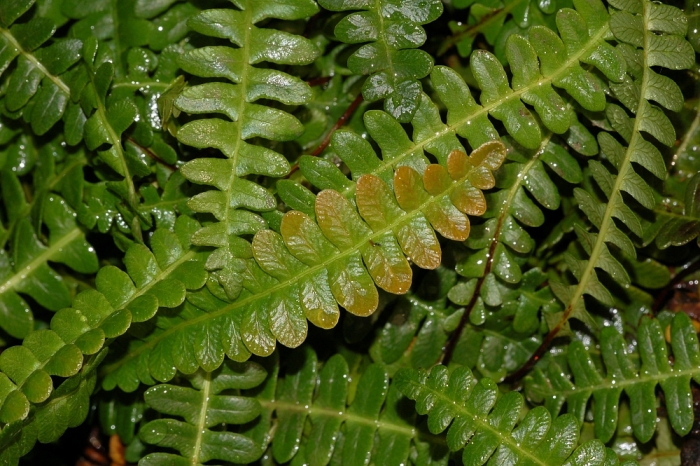Alpine Water Fern
(Blechnum penna-marina)
Alpine Water Fern (Blechnum penna-marina)
/
/

Fritz Geller-Grimm
CC BY-SA 2.5
Image By:
Fritz Geller-Grimm
Recorded By:
Copyright:
CC BY-SA 2.5
Copyright Notice:
Photo by: Fritz Geller-Grimm | License Type: CC BY-SA 2.5 | License URL: https://creativecommons.org/licenses/by-sa/2.5 | Uploader: Dysmachus | Publisher: Wikimedia Commons | Title: Blechnaceae_Blechnum_penna_fg01.JPG | Notes: |

























































Estimated Native Range
Summary
Blechnum penna-marina, commonly known as Alpine Water Fern, is an evergreen fern native to cool temperate forests, subalpine regions, and peat bogs in South America, New Zealand, and the Subantarctic Islands. It typically grows to a height of 0.5-0.7 feet (15-20 centimeters) and a width of 0.3-0.6 feet (9-18 centimeters). This fern has a creeping rhizome and features a rosette of pinnate, dark green fronds that are leathery to the touch. The Alpine Water Fern does not produce flowers but has fertile fronds that bear spores underneath, which are less showy than flowering plants but contribute to its lush, green appearance.
The Alpine Water Fern is valued for its low-growing, spreading habit, making it an excellent ground cover in shady garden areas. It is also used in rock gardens and alongside water features for its textural interest and evergreen foliage. This fern requires consistently moist soil and thrives in acidic to neutral pH conditions. It prefers cool environments and may struggle in hot, dry climates. While generally low-maintenance, it can be susceptible to fungal diseases in overly wet conditions. It is not known to be invasive when grown outside its native range.CC BY-SA 4.0
The Alpine Water Fern is valued for its low-growing, spreading habit, making it an excellent ground cover in shady garden areas. It is also used in rock gardens and alongside water features for its textural interest and evergreen foliage. This fern requires consistently moist soil and thrives in acidic to neutral pH conditions. It prefers cool environments and may struggle in hot, dry climates. While generally low-maintenance, it can be susceptible to fungal diseases in overly wet conditions. It is not known to be invasive when grown outside its native range.CC BY-SA 4.0
Plant Description
- Plant Type: Fern
- Height: 0.5-0.7 feet
- Width: 0.3-0.6 feet
- Growth Rate: Slow
- Flower Color: N/A
- Flowering Season: Non-Flowering
- Leaf Retention: Evergreen
Growth Requirements
- Sun: Part Shade, Full Shade
- Water: High
- Drainage: Medium
Common Uses
Bank Stabilization, Deer Resistant, Groundcover, Low Maintenance, Potted Plant, Rock Garden
Natural Habitat
native to cool temperate forests, subalpine regions, and peat bogs in South America, New Zealand, and the Subantarctic Islands
Other Names
Common Names: Antarctic Hard-Fern, Pinque
Scientific Names: , Blechnum penna-marina, Austroblechnum penna-marina subsp. penna-marina, Blechnum penna-marina var. bolivianum, Blechnum penna-marina var. boliviana, Blechnum penna-marina subsp. boliviana, Blechnum parvifolium, Lomaria penna-marina, Blechnum penna-marina var. uliginosa, Lomaria antarctica
GBIF Accepted Name: Austroblechnum penna-marina subsp. penna-marina